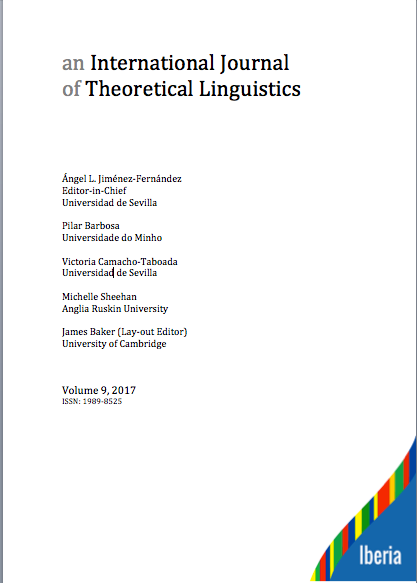RESTRICTIONS IN THE SEMANTIC INTERPRETATION OF ENGLISH AND SPANISH COMPOUNDS
Keywords:
compound, morphology, semantics, word structureAbstract
In this paper we claim that the differences between the semantic interpretation of English and Spanish compounds having identical categories (i.e. Noun + Noun) are determined by their syntactic structure. Assuming the already well-known division between structural semantics (the meaning provided by the syntactic structure) and conceptual semantics (the idiosyncratic meaning with which the construction is stored in the lexicon), we will try to demonstrate that the most productive patterns of compounding in both languages display a systematic contrast: the English constructions (i.e. paperboard, red-haired or dish-washer) has less structural complexity than the Spanish ones (i.e. papel carton, pelirrojo or lavaplatos). As a consequence of that, the amount of conceptual meanings that each member of the three compound patterns can receive in the English language is considerably bigger than in the Spanish language. This correlation between structures and conceptual meaning will be tested with Noun+Noun compounds, Adjective+Noun compounds and, finally, with Noun+Verb compounds. The differences found in all of them are triggered by the kind of relational structure that links the lexical units inside the compounds.Downloads
References
Bauer, Laurie. 2003. Introducing Linguistic Morphology. Washington, DC: Georgetown University Press.
Borer, Hagit. 2013. Taking form. Oxford: Oxford University Press
Benczes, Rita. 2005. Creative Noun–Noun Compounds, Annual Review of Cognitive Linguistics 3, 250–268.
Buenafuentes de la Mata, Cristina. 2007. Procesos de gramaticalización y lexicalización en la formación de compuestos en español. PhD Dissertation. Barcelona, Universidad Autónoma de Barcelona.
Cinque, Guglielmo. 2014. The semantic classification of adjectives, a view from syntax, Studies in Chinese Linguistics 35(1), 1–30.
Gagné, Cristina & Thomas L. Spalding. 2006. Using conceptual combination research to better understand novel compound words, SKASE Journal of Theoretical Linguistics 3(2), 9–16.
Goldberg, Adele. 1995. Constructions: A Construction Grammar Approach to Argument Structure. Chicago: University of Chicago Press.
Delfitto, Denis, Antonio Fábregas & Chiara Melloni. 2008. Compounding at the interfaces, Ms. University of Verona. Paper presented at NELS.
https://www.researchgate.net/publication/267693166_Compounding_at_the_interfaces (20 de Diciembre de 2016)
Downing, Pamela. 1977. On the Creation and Use of English Compound Nouns, Language 53 (4), 810–42.
García-Lozano, Fernando. 1997. Los compuestos de sustantivo+adjetivo de tipo pelirrojo, Iberoromania 7, 82–89.
Guéron, Jaqueline. 1983. The possessive use of the definite article in French, Langue francaise 58, 23–35.
Langacker, Ronald. 1999. Grammar and conceptualization (Vol. 14). Berlin: Walter de Gruyter.
Lieber, Rochelle. 2004. Morphology and Lexical Semantics. Cambridge: Cambridge University Press.
Fábregas, Antonio. 2005. The definition of the grammatical category in a syntactically oriented morphology. Nouns and Adjectives. PhD Dissertation. Madrid: Universidad Autónoma de Madrid.
Fábregras, Antonio. 2015. Structural sensitivity as an argument for Semantic Underspecification. In Laurie Bauer, Livia Körtvélyessy & Pavol Stekauer (eds.), Semantics of Complex Words. 217–241. Switzerland: Springer International Publishing.
Fábregas, Antonio. 2016. Las nominalizaciones. Madrid: Visor.
Gil-Laforga, Irene. 2014. La interacción de los componentes gramaticales en la formación de palabras: adjetivos posesivos derivados y compuestos. PhD Dissertation. Madrid: Universidad Autónoma de Madrid.
Jackendoff, Ray.2009. Compounding in the Parallel Architecture and Conceptual Semantics. In Rochelle Lieber & Pavol Stekauer (eds.), The Oxford Handbook of Compounding, 162–203. Oxford: Oxford University Press.
Halle, Morris & Alec Marantz. 1993. Distributed Morphology and the Pieces of Inflection. In Ken Hale & Samuel Jay Kayser (eds.), The View from Building 20, 111–17. Cambridge, MA: MIT Press.
Levi, Judith N. 1978. The Syntax and Semantics of Complex Nominals. Cambridge: Academic Press.
Lieber, Rochelle. 1983. Argument linking and compounds in English, Linguistic inquiry 14(2), 251–285.
Lieber, Rochelle & Pavol Stekauer (eds.). 2009. The Oxford Handbook of Compounding. Oxford: Oxford University Press.
Matthews, Peter H. 1991. Morphology. Cambridge: Cambridge University Press.
Padrosa, Susana. 2010. Complex Word Formation and the Morphosyntax Interface. PhD Dissertation. Barcelona: Universidad Autónoma de Barcelona.
Ponce de León, Zacarías. 2015. Compuestos metonímicos en español. ¿Exocentricidad o predicación de punto de referencia?, Onomázein 32(4), 62–79. México: Universidad Nacional Autónoma de México.
Pustejowsky, James. 1991. The Generative Lexicon: a computational Theory of Linguistic Semantics, Computational Linguistics 17(4), 409–441.
Varela, Soledad & Elena Feliú. 2003. Internally motivated structural borrowing in Spanish morphology. In Paula Kempchinsky & Carlos E Piñeros (eds.), Theory, Practice and Acquisition, 83–101. Sommerville: Cascadilla Press.
Yoon, Jiyoung. 2014. The role of constructional meanings in novel verb-noun compounds in Spanish, In Hans Boas & Francisco Gonzálvez-García (eds.), Romance Perspectives on Construction Grammar, 37–78. Amsterdam: John Benjamins.
Published
How to Cite
Issue
Section
License
Las ediciones impresa y electrónica de esta Revista son editadas por el Secretariado de Publicaciones de la Universidad de Sevilla, siendo necesario citar la procedencia en cualquier reproducción parcial o total.Salvo indicación contraria, todos los contenidos de la edición electrónica se distribuyen bajo una licencia de uso y distribución “Creative Commons Atribución-NoComercial-SinDerivar 4.0 Internacional”

